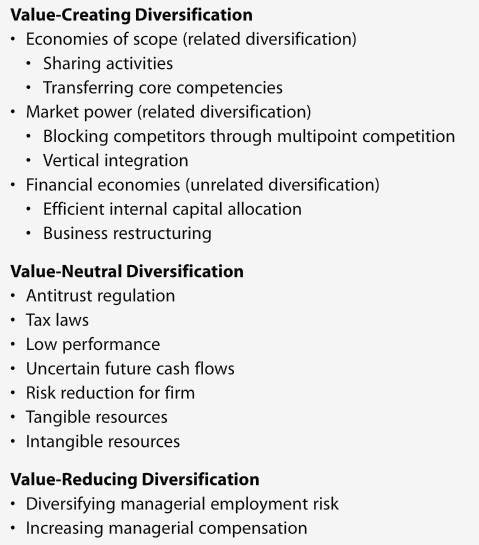The Differences Between Related Diversification and Unrelated Diversification
Post on: 1 Октябрь, 2015 No Comment

Which Strategy Best-Fits Your Business?
Why diversify?
A diversification analysis needs to demonstrate, and support, that the business will achieve a return on the investment that more than compensates for the risk and the cost.
A business owner needs to consider efficient diversification strategies to build a competitive advantage, to achieve economies of scale or scope, and/or to take advantage of a financial opportunity that aligns with the business’ strategic plan .
Diversification can be segmented into related diversification or unrelated diversification.
What is Related Diversification?
It is when a business adds or expands its existing product lines or markets. For example, a phone company that adds or expands its wireless products and services by purchasing another wireless company is engaging in related diversification.
With a related diversification strategy you have the advantage of understanding the business and of knowing what the industry opportunities and threats are; yet a number of related acquisitions fail to provide the benefits or returns originally predicted.
Why? It is usually because the diversification analysis under-estimates the cost of some of the softer issues: change management, integrating two cultures, handling employees. layoffs and terminations, promotions, and even recruitment. And on the other side, the diversification analysis might over-estimate the benefits to be gained in synergies.
What is Unrelated Diversification?
It is when a business adds new, or unrelated, product lines or markets. For example, the same phone company might decide to go into the television business or into the radio business. This is unrelated diversification: there is no direct fit with the existing business.
Why would a company want to engage in unrelated diversification? Because there may be cost efficiencies. Or the acquisition might provide an offsetting cash flow during a seasonal lull. The driver for this acquisition decision is profit; it needs to be a low risk investment, with high potential for return.
Efficient Diversification:
Ensure that you review the costs and benefits of investment
- in new equipment;
- in labor saving costs;
- in improving productivity and/or workflow;
- in serving existing customers better and more profitably;
- in diversifying by adding new products and services and/or new markets;
- by addressing safety and/or environmental issues; and more.
Does your capital investment plan leverage diversification?
Assess the Opportunity for a Good Return:
New markets and new products or services are usually good diversification opportunities; but consider these opportunities in the context of integrating benefits into a much stronger overall unique value proposition.
Does adding the new products or services provide you with a leveraged opportunity?
For example, if you are a commercial printer and you add basic graphic design services and packaging services to your product line, you will have a leveraged diversification opportunity.
Why? Because your print services can be combined with graphic design services upstream (same end client) and be combined with packaging services downstream (same end client and/or same destination). You will have saved your client time and money by enabling the client to ‘shop’ in one-stop (providing you can excel at delivering those services).
If you are prepared (and able) to invest in your business during either good or challenging times, make sure that you develop business performance measures to track the costs and the benefits expected?
You need to ensure that the advantages of diversification and the expected benefits from investment are met as you planned.
Ensure that you build those business measures, set up reporting (even if it’s a manual process), and make sure that someone is accountable for the planned results.
Understanding the advantages and disadvantages of unrelated or related diversification strategies is important to the growth of your business.














